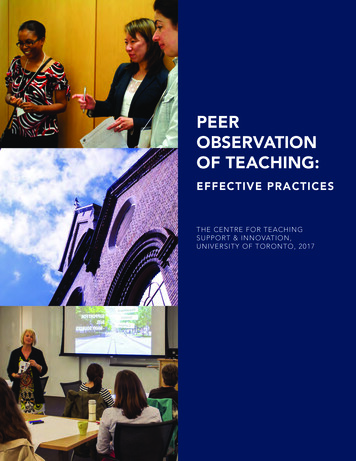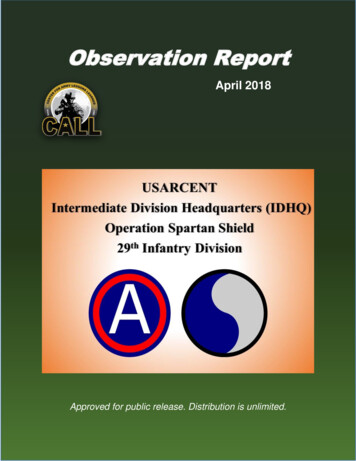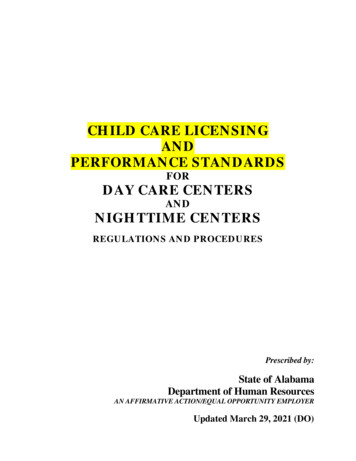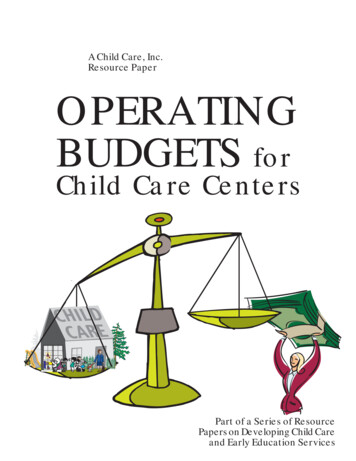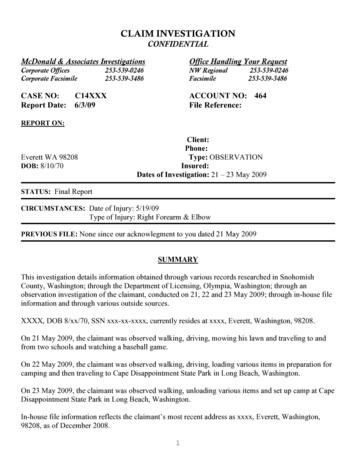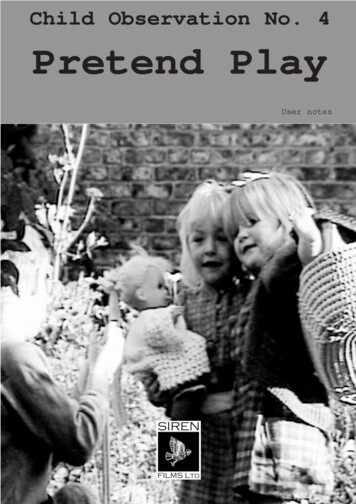
Transcription
Child Observation No. 4Pretend PlayUser notes
ContentsAims of the film and its use.31 “Isobelle cleans up”20 months.42 “Angus feeds dolly”20 months.53 “Joanne’s tea party”2.5 years.64 “The dancing class”3 years.85 “Harley gets dinner”4 years.96 “Two play mums & dads” 3.5 & 4 years.117 “Cats & dogs”3.5 & 4 years.138 “Gladiators”4 & 5.5 years.159 “The factory office”3.5 & 4 years.1610 “Orphans”4.5, 5.5 & 7 years.1911 “The journey”4.5, 5.5 & 7 years.22References & further reading.23
Aims of the film and its usePretend play, sometimes also referred to as fantasy, symbolic or role play, is generallyseen as being especially important for the development of children’s thinking. Here wepresent sequences of children’s pretend play from 20 months to 7 years to show its general development. Most theorists and experts agree that pretense is a main element inmuch of the play for that age group, with extensive links to learning and development.Pretend play involves being a symbol user, where one thing stands for another, and helpshumans to think beyond the here and now. It encourages children to think in abstractways and allows them to imagine. The ability to imagine allows them to experience andrespond creatively to ideas, feelings and relationships.Pretend play starts once the toddler is able to symbolise. The play is initially very simpleand usually involves pretending with an object. At around three years, children begin todevelop pretend games with their peers. This stage of pretend play is often referred toas socio-dramatic play and involves simple role play, gradually becoming more complex and sustained.The dvd sequences showing examples of pretend play are presented in order of age,from 20 months to 7 years.For each sequence we provide:A brief description:A short description of the sequence and it’s salient featuresGood for looking at:Examples of:! specific aspects and developmental stages of pretend play! associated learning and developmentTranscript:A transcript of the language is provided for the sequences where children’s language isa major part of the sequenceDiscussion:Suggestions of relevant issues and starting points for discussions related to the sequence3
1 “Isobelle cleans up”3 mins20 monthsA brief description:Twins, Isobelle and Angus, are playing at home looked after by their mum. Isobelle hasfound some paper tissues. She begins carefully cleaning different objects around theroom imitating domestic activity. She makes speech like sounds with conversational intonations as she talks to herself about what’s happening. The decipherable words she saysare “that’s good”. She appears absorbed and happy.Good for looking at:Solitary play, with objectsEarly stages of pretend play, using simple pretend actions that involve other objectsLanguage development, talks to her self and beginning to use two wordcombinations! Fine motor skills, cleans objects carefully with tissue!!!Discussion:Think about the way Isobelle is learning to make sense of the adult world.What is Isobelle learning?How might you extend her learning opportunities following her interests?4
2 “Angus feeds dolly”2.5 mins20 monthsA brief description:Angus is at home being looked after by his mum. He is sitting on the floor having a snackand begins to feed the doll lying next to him. He’s careful to make sure that the smallbits of food go exactly where the doll’s mouth is.Good for looking at:! Solitary symbolic play, with doll! Early stages of pretend play, using simple pretend actions that involve other objects! Fine motor skills, delicate pincer grasp to pick up small objects! Hand eye coordination, making sure food goes to doll’s mouth! Emotional development, treats doll as similar to himself, needs feeding and caring forDiscussion:“Toddler time is a crucial period for the development of play. It is the time when play hasthe possibility to develop the features which use the rehearsal of roles, pretending, imagining and creating play props. This is all part of the symbolic explosion which occurs asthe toddler turns into a talker and a player with symbols.” Tina Bruce, Learning ThroughPlayWhat other kind of objects would encourage symbolic play at this age?Do you think certain toys are for boys and others for girls?How might an adult’s views about what each gender should play with affect their learning?5
3 “Joanne’s tea party”3 mins2.5 yearsA brief description:Joanne is playing at home with her mum. She is playing with a tea-set, sharing a drinkwith some of her toy animals. She gives a steady stream of conversation about what ishappening. Her mum repeats clearly what she is saying and is careful to try and interpret correctly. She takes care, attending to the needs of her animals imagining whatthey are wanting. Joanne sustains this play for ten minutes.Good for looking at:!!!!Early pretend play with an adultSocial and emotional development, takes care attending to the needs of her toyanimalsThree and four word sentences with indistinct pronunciationMum repeats clearly what Joanne has said and is careful to interpret correctlyTranscript:JoanneMumNouse (mouse)Oh very good, a lovely cup of teaIs that nice?Some for Joanne. What about donkey?Does donkey want some?It’s nouse dup of teaThat’s mouse’s teaDonkey’s big teaIs donkey having some tea?All goneAll gone nowThank you very muchDonkey (---- indistinct) dis oneDonkey’s going to have someMouse has finishedDonkey’s6
JoanneMumDonkey!Oh dearAll goneAll gone now. Thank youDonkey’s (----- indistinct)Donkey’s?Donkey’s finished?Oh. He wants another one!YesDonkey’s nother oneMummy’sAnd one for MummyIt’s mummy’s teaAnd one for mouseNouse (mouse)There he isSink (drink) teasdonkey’sAha, donkey’sAll goneAll gone now(----- indistinct)Are you going to put these away now?Discussion:“Pretend play provides children not only with the opportunity to begin where they currently ‘are’ but to use their real and imaginary experiences for language and learning.”Moyles 1989“Young children cannot always find the words to express what they are actually capable of exploring through their internal and personal development of language andthought.” Moyles 1994What is this play situation encouraging Joanne to learn?How does Joanne’s mum help her language development?7
4 “The dancing class”6 mins3 yearsA brief description:James is at nursery school in a class of similar age children. In addition to the teacherthere are two other adults in the room.James wants to wear a pink dress. A girl on work placement tries to discourage him buthe puts it on any way. The teacher encourages him by becoming involved in the dressing up game. Seeing James do a few dance steps she suggests a dancing session forthe whole group. James seems happy and confident throughout as he tries out a different role. (The teacher knows that his elder sister is a dancer)Good for looking at:Role play, dressing up, trying out being a dancer, seeing what it feels like to wear adress and high heels, carrying a bag, getting ready, looking in the mirror, brushing hair.! Adult getting involved in the play and extending it by arranging a dance! Physical development, dancing, body coordination and expression throughmovement!Discussion:“Children inhabit a social world that is organised, to a large degree, according to gender. The expectations and responses of significant adults exert a subtle but powerfulpressure on boys and girls to behave in sex-appropriate ways. It is likely, and perhapsinevitable, that children will explore gender boundaries and identify in socio-dramaticplay as they seek to come to terms with who they are as individuals. Their play will render valuable information and offer insights to educators who wish to understand childenbetter in order to enrich their development and to meet their needs as individuals within a social context.” Hislam, 2005What do you think about the reaction of the two adults in the sequence?How might you have reacted to James in this situation?Why is the home corner equally important for both boys and girls?8
5 “Harley gets dinner”5 mins4 yearsA brief description:Harley is playing on her own at home. She has just finished setting out and sorting a teaset, cutlery and pretend food. She talks to herself and pretends to eat the food, thinking hard about which piece of cutlery will be most appropriate for which food item. Shepractices counting and tries to work out how many ‘babies’ she needs to solve a problem that she is imagining. She handles one of the dolls lovingly, and a hat is put to various uses – it becomes a potty, a chair for watching television and finally a sunshade.Good for looking at:!!!!!Solitary play, with dolls and tea setMathematical development, counting, sorting, problem solvingLanguage development, talking about what she is doing with a constant narrativeSymbolic use of object, using one object to stand for another, the hat becomes apotty, a chair and a sun shadeSocial and emotional development, loving towards her doll but can also behaveunacceptably towards her doll throwing her across the roomTranscript:HarleyHave a knifeAnother knifeA spoonNow I’m going to eat it all upYummy yummy in my tummySpoon for thisFork for thisYummy yummyI need a spoon for thisI can only take one baby in the world9
HarleyOne baby1, 2, 3, 4, 5I need 5 babies1,2,3,4,5I need 5 babiesI bringed some babiesCome on, come onYou two can walk if this baby can walkYour still crying(Indistinct)Now put your botty in thereOh that’s alrightOh this is mummy’s, found my hat(Indistinct)Now put your baby right thereWe’re not in the sun nowYou watching teleYou can see your friends nowHer just messing the placeHey stop messing the place!Discussion:Young children of both sexes act out roles, often as narratives, with great intensity andseriousness of purpose. As they do so, they develop language skills, try out behavioursand ways of being girls and boys and become more confident communicators and storymakers.” Hislam 2005Discuss what you think Harley is experiencing and learning during her play.Why do you think Harley talks to her self while she is playing ?Think of some ideas of how you might join in Harley’s game to extend her play andlearning?10
6 “Mums and dads”(Playinghouse)3.5 mins3.5 & 4 yearsA brief description:Harley 4, and cousin Lauren 3.5 years are playing together in Harley’s bedroom. The twogirls are playing ‘house’.Harley, on the right of the screen initially, changes role a number of times. Firstly she isdaddy – being quite assertive with her body language and giving instructions. Lauren,as mummy, starts the ironing.Then Harley takes on the role of a little girl and changes her voice level. She tells Laurento scold her for licking Grandma and Grandad's ice-cream. Lauren does this but Harleytakes no notice of being told off and continues to ‘eat’ the ice-cream until it’s gone.Harley now becomes the baby. Again she sets up a situation whereby she can be toldoff – this time for making a noise.Good for looking at:Socio-dramatic play, develop make believe game taking on agreed rolesBeginning to step in and out of rolesLanguage and communication development, creative verbal and nonverbalcommunication to act out their roles! Knowledge of the world, theme for game taken from family life, drawing fromprevious experiences! Social and emotional development, making sense of the adult world, trying outsituations!!!Transcript:HarleyLaurenI’m the mummyNo. I’m the mamI’m the daddaI need something to ironI think you iron thisNo I won’t iron thatIt’s a dress. This is dirty11
HarleyLaurenRightTend (pretend) it’s dirtyWill you take Barney’s clothes off (to camera person)No iron thisYou gotta say ‘top licking da iye cream’Stop licking that ice creamit’s for grandma and motherIt’s for grandma and motherGrandad and grandmaGrandad and grandmaStop eating itI finished it mummy and you’ve got a say‘good girl”Good girlLet’s see thatIt’s powderThis is baby foodMe and Jay, eat baby foodGa gaI be the little babyGa gaYou’ve gotta say ‘stop shaking that’Ga gaStop shaking thatWill you open that, babyBaby powderYes. I open itNo it’s mam’s powderDiscussion:“A child plays with her doll not soley for the role of a protective figure, but also (like herown mother) as a power figure; little girls disciplining their doll families can be a disconcerting experience, especially for the mother who recognises her own bossy voice. Forthe child to adopt a role of power is most valuable to the process of identifying with parents and internalizing their standards of behaviour” Newson 1979How does Harley communicate the different roles she takes on?How is the game being used to express the children’s feelings?12
7 “Cats and dogs”3 mins3.5 & 4 yearsA brief description:A little later we see Harley and Lauren make use of a book (‘Mog the Forgetful Cat’ byJudth Kerr) as a springboard for an imaginative game. Harley has chosen the book anddirects the action. She cooperates when Lauren says she doesn’t want to be the ‘pussycat’. Harley pretends to be the cat and Lauren is the little girl who feeds the cat by pretending the talcum powder is milk. Lauren extends the make-believe in her own way byattending to some toy dogs. Harley scratches a doll on the face and then licks the dollclean.Good for looking at:!!!!!Socio-dramatic play, develop make believe game taking on agreed rolesLiteracy, drawing inspiration for game from a story bookLiteracy, using language from story book style ‘A long long time ago.’Social and emotional development, beginning to be able to negotiate whenworking out their roles, Harley is showing sensitivity towards LaurenLanguage and communication, directing and discussing the flow of their pretendthemeTranscript:HarleyLaurenLet me have a seeI’m the girlThat’s Jay and you the pussy catNo I’m not pussy catAlright I be the pussy catThere’s Jay and there’s me and I knowwhere you’ve goneThere you. Yes that’s me. There meLong long time ago Lauren says get afood here pussy cat13
HarleyLaurenThere where I’m sleepingNo I have to put it on your faceI’m the cat, miaowThis is your powderCat foodI will put some milk inThese were my dogsI’m licking the little girlLick the little girl, nice and cleanPowder there, powder thereIt’s called milkIt’s called milkNo that was my bagI want to be the dadI’m powdering thisNice and clean now for meNo that was mineDiscussion:“.play is not just about fantasy. It doesn’t have a life of its own which is divorced fromreality. Children continuously weave in and out of their play their knowledge skills andunderstanding learned in the other areas of their lives.” Wood & Attfield 1996How has Harley adapted the story to fit in with her own situation ?What does this sequence tell you about the value of reading stories to children?How does Lauren adapt the game that Harley has made up, to fit her own interests?14
8 “Gladiators”3 mins4 and 5.5 yearsA brief description:Harley is playing in her front garden with two 5.5 year old boys – Jay, her brother and theirneighbour Stephen. Jay, in yellow, suggests a game of Gladiators (a television programme where contestants have to compete with super sports heroes with fantasynames).The children each take on a specific role which in this case involves being eitherWerewolf, Cobra or Foxer. Jay, who is the leader in this game, allows the other two tochoose their ‘personas’ first. He quickly establishes the rules which the other two seemhappy to comply with. During the game the children extend themselves and practicetheir physical skills to the limit. The older boys are skilful in climbing and swinging anddoing ‘stunts’. Harley, this time the youngest child, is much less dominant and vocalthan in the previous sequences.Good for looking at:Fantasy play, based on non-real characters from television showSocial and emotional development, Jay shows signs of diplomacy and welldeveloped social skills as he allows the other two to choose their ‘personas’ first, hequickly establishes the rules! Enjoying team games with rules! Physical development, climbing, swinging and performing ‘stunts’!!Discussion:“There are sound reasons to be concerned if physical play is down graded along withoutdoor and energetic play for children. Apart from the great importance of physicalskills in their own right for children, many of the more valued intellectual activities arehighly dependent on confidence and practice in physical skills.” Lindon 2001Discuss the value of the outside environment for children’s development.How could this outside play area be enriched?How do the children relate to each other?What do you think about their game being based on a television programme?15
9 “The factory office”5 mins3.5 & 4 yearsA brief description:Christopher, Megan and Vicky aged 4 are playing together at nursery. They are joinedlater by Zoe and Kayleigh aged 3.5 years as their game progresses. There are two adultsin the setting.Christopher, Megan and Vicky are in the ‘writing corner’. They are cutting out paper intheir factory office. They decide to be dad and two mums. The girls are making phonecalls and Christopher is cutting out various sized trousers to go in the factory window. Hetests out who the trousers will fit by measuring them against themselves. Two youngergirls arrive and are told they can be the children. They pretend to be naughty childrenand ‘dad’ tells them off. The children continue giggling ‘naughtily’. Christopher establishes his authority by telling ‘mum’ that “This is really my office isn’t it? But for the first timeI let mum in didn’t I?” and pats Megan on the shoulder. Mum agrees “I needed to goto work.”Meanwhile the ‘children’ are getting ‘naughtier’ and decide to steal some scissors.Christopher politely asks for their return, supported by his ‘wife’ who says “Those are mydad’s scissors.” The ‘children’ however are intent on being ‘naughty’. One of the adultsintervenes to tell Zoe she must not run with the scissors because it is dangerous. All thechildren communicate their roles non-verbally, through body language, as well asspeech.Christopher and Vicky continue the game for a further ten minutes.Good for looking at:!!!!!Complex socio-dramatic play, develop make believe game taking on agreed roles,directing and discussing the flow of their pretend themeLanguage and communication development, imitating words and tone of voicePhysical development, using scissors to make changes to the paperPhysical development, manipulating materials to achieve a planned effect, makingtrousers out of paperMathematical development, measuring and comparing sizes16
Transcript:ChristopherVicky4 year old girlThis is dad’s and mum’sofficeI’m the mum and you’rethe daddyNo I’m the mumThere could be two mumsMum has to cut somethingout and she has to get cutting out things outWe have to make trousersdon’t forget(No you said mum’s)Were a factory aren’t weYes we’ve a factoryAnd factories have tomake everything we need clothesThere ---Where shall we put themOh yes we’ll just put themin the window(phone call)Do you want to come totea Emmy and me andmummy and Vin andJames?Do you want to come totea?Yes. Bye byeI’ve done nowI’ll be a doctor(Phone call)Hello - daddy at workThere are some babytrousersNo I mean these are shortsThese shorts won’t fit meThese are for babiesWhich is my ruler dad?Do you think the glass one’smy rulerAh the glass ones mine17
ChristopherVicky4 year old girlThis one’s yoursNo this ones mineHere we go!A nice funny thingI don’t know what it isthough too many holes in it- I going to put that in thebin. Our bin used to behereI’m afraid there’s no room(to younger children)Yes I’m afraid it’s no room.There’s no room!You can be our children31/2year old girlLook out the windowLookGiggleWe’re trying to work children!Stop it childrenThis is really my office isn’tit? But for the first time I letmum in didn’t I?Yes ‘cos I needed to go towork didn’t I?So you need to learn in thisoffice don’t you9-8How do you do 9-8?This is our officeDad will you look after mychair?Discussion:“The child always behaves beyond his average age, above his daily behaviour. In playit is as if he were a head taller than himself.” Vigotsky 1978Do you think this idea applies to the children playing this game?How is the game developing the children’s development in the following areas:mathematical, physical, emotional & social, communication, language & literacy,knowledge & understanding?18
10 “Orphans”4 mins4.5, 5.5 years & 7 yearsA brief description:Three children of different ages play together in one of their gardens.Katrina, 7, knits, Colette, 5.5, holds her doll and Beth, 4.5, has a moses basket. They arediscussing the scenario for their game. They decide that they are all teenagers and theirmum had died and their dad had gone away for a hundred years. They love him andreally miss him. Colette is going to have a baby. The baby’s grandad is deaf and theypractice sign language, making up signs they can’t remember.Good for looking at:!!!!!!Complex socio-dramatic play, develop make believe game taking on agreed roles,directing and discussing the flow of their pretend themeRehearsing the way young adults behaveEmotional well being, exploring their experiences of family life, love and separation,fears and anxietiesEmotional and social development, beginning to manage, explore and deal withtheir feelingsLanguage and communication development, using language to organise feelingsand eventsKnowledge and understanding, knowing that deaf people communicate with signlanguageTranscript:Katrina (7)Colette (5.5)Beth (4)Our mam had diedYeah, our mam had diedAnd wa dad(‘wa’ dialectfor our)Yeah – no our dad wentaway for a hundred yearsYeah and we never sawhim again did wa?I’m sixteen19
Katrina (7)Colette (5.5)Beth (4)LaughsAlright then I’ll be nineteenYou be sixteenI’m as big as her in thegameEeh we really are nearly thesameBeth’s much bigger thanyouShe’s notRight. Back to backWe always do back tobackYou’re up to there on herYeah well that’s quite. Sheisn’t much more biggerthan me thenAbout two inches moreI know Chloe (doll) yourdad’s gone away and youwant himThat’s not her dad it’s hergrandadYeah. Can I have this babyborn out of my tum?Yeah, but you look after itPretend she was trying towalk and she fell there –right?YeahPoor thing, and she wassad because her grandadhad gone away and shereally loved himAnd she had a greatgrandad as wellI know how to do ‘goodnight’ in deaf signingGo on thenAh pretend who could bedeaf, cause I’m not deafYou weren’t deaf. Our20
Katrina (7)Colette (5.5)Beth (4)grandad was deafAnd this was ‘good nightgrand’ Oh I can’t remember GrandadJust do ‘grandad’She’ll be going to bed soonNo, he was blindSo he had to say the wordsSo he had to hear thewords, didn’t heDiscussion:Vivian Paley (1988) was interested in children’s fantasy play.“.because it is the main repository for secret messages, the intuitive language withwhich children express their imagery and logic, their pleasure and curiosity, their ominousfeelings and fears.”Why do you think it is important for children to be able to work through big ideas in theirplay?What issues do you think the children are exploring during their game?Why do the children step in and out of their roles during their game?Why do you think outside space is important for children, even when they are not running around or being highly active?21
11 “The journey”1.5 min5.5 & 7 yearsA brief description:Katrina joins Collette in their den in the hedge where Colette is cutting up apples. Theyare imagining going on a journey and behaving in a way they know is unacceptable inreal life, going camping without asking their parents, sneaking food and money fromtheir mums. In their den they can pretend whatever they like and imagine what it wouldfeel like.Good for looking at:!!Emotional and social development, experimenting with what it might feel like tobreak rules and behave unacceptablyCommunication and language development, using language to organise thoughts,feelings and eventsTranscript:KatrinaColetteI’m not doing the plums againI would like to go out camping withoutasking me mum and dad, with you - rightand ermSneak some foodYes and sneak all wa (dialect for ‘our”)mam’s moneyLaughsNo you’ve got to mush it like this.Go and get yourself a knifeand then set off for the journeyDiscussion:Do you think dens are important spaces for children to work through their feelings in private or a place where children can be naughty away from adults?22
References & further readingBeaver, M. et al (1994) Babies and Young Children: Development 0 – 7. StanleyThornesBrennan, J (1987) Curricular Needs of Slow Learners, Evans/Methuen for School CouncilDuffy, A. et al. (2006) Working with Babies and Children under Three. HeinemannEducational Publishers.Fawcett, M. (1996) Learning Through Child Observation. Jessica Kingsley Publishers.Hislam, J. (2005) Story-making, play and gender. In Moyles J. (Ed) The Excellence ofPlay. 2nd edition. Open University Press.Hughs, A. M. (2006) Developing Play for the Under 3s: Treasure Basket and HeuristicPlay. David Fulton PublishersHurst, V. (1994) Observing Play in Early Childhood. In Moyles, J. The Excellence of Play.Open University Press.Lindon, J. (2001) Understanding Children’s Play. Nelson Thornes.Lindon, J. (2005) Understanding Child Development. Linking Theory and Practice.Hodder Arnold.Manning Morton, J. and Thorp, M. ((2003) Key Times for Play: The First Three Years.Maidenhead: Open University Press.Meggitt, C. (2006) Child Development: an illustrated guide, birth to 16 years. 2nd edition. Heinemann 2006Paley, V. G. (1988) Bad Guys Don’t Have Birthdays: Fantasy Play at Four. Chicago:Chicago University Press.Isaacs, S. (1933) Social Development in Young Children. Routledge and Keegan Paul.Kitson, N. (1994) Fantasy play: a case for adult intervention. In The Excellence of PlayLee, C. (1990) The Growth and Development of Children. Longman.Moyles, J. (1989) Just Playing. Open University Press.Moyles, J. (1994) The Excellence of Play. Open University Press.23
Moyles, J. (2005) The Excellence of Play. 2nd Edition. Open University Press.Neelands J. (1994) Making Sense of Drama. London. Heineman.Newson, J. & Newson, E. (1979) Toys and Play Things. Penguin Books Ltd.Piaget, J. (1966) Foreward. In Almy, M (Ed), Young Children’s Thinking. Teacher’sCollege Press.Riddall-Leech, S. (2005) How to Observe Children. Heinemann Educational Publishers.Vygotsky, L. (1978) Mind in Society. In Cole et al (Ed), Mind in Society. HowardUniversity Press.Wood, E. & Attfield, J. (1996) Play learning and the Early Years Childhood Curriculum.London: Chapman.24
Siren produces a range of other child development filmsand all follow children in everyday situations. Some areconventional films while others are specifically designedfor learning observation skills and consist of valuablesource material.Siren Films ltd. 5, Charlotte Square, Newcastle upon Tyne, NE1 4XFTel: 0191 232 7900 Fax: 0191 261 6620 e-mail: info@sirenfilms.co.ukweb site: www.sirenfilms.co.uk
Harley 4, and cousin Lauren 3.5 years are playing together in Harley’s bedroom. The two girls are playing ‘house’. Harley, on the right of the screen initially, changes role a number of times. Firstly she is daddy – being quite assertive with her body language and g

